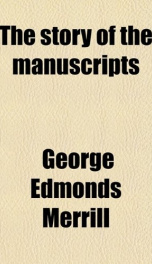the story of the manuscripts

Purchase of this book includes free trial access to www.million-books.com where you can read more than a million books for free. This is an OCR edition with typos. Excerpt from book: CHAPTER II. BOOKS IX AXCIENT TIMES. If the method in which books were made, before the art of printing and the improvements in the materials used in their manufacture gave them their present form, be considered, the story of the manuscripts will be the more easily told and understood. It will avail nothing to speak of the tablets used by the Greeks and Romans, even at the very time when the" Christian Scriptures were beginning to be written, nor of other forms of books more ancient still, like slabs of stone or metal, which would be of the greatest importance were the present discussion with reference to the writings of the Old Testament. We have only to do with the kind of books that were in general use in the lands of the apostolic writers, and the materials which they commonly employed. And it is sufficient to note of all preceding writings, that the rudest forms had long since yielded to ingenious improvements, as civilization had advanced, so that in the times of the New Testament facilities for writing existed, which former ages would have counted themselves rich to possess. No longer were men engraving their histories in rude cuneiform characters upon such tablets of baked clay as were found in the ruins of the palaceof Koniunjik, at Nineveh, of about 670 B. C., and as they may still be seen in the British Museum. Even the delicate wood and ivory plates were now for the most part displaced among Greeks and Romans. When the writings of the New Testament were made, the river Nile had already been yielding for centuries its harvests of reeds, out of which a substance was manufactured more nearly resembling modern paper, than anything that had yet been seen. Fine skins of leather were also sewed together, forming long strips, which were rolled up upon wands after they...
Info about the book
Author:
Series:
Unknown
ASIN:
B0006AM67E
Rating:
4.5/5 (4)Your rating:
0/5
Languge:
English
Users who have this book
Users who want this book
What readers are saying
What do you think? Write your own comment on this book!
write a commentGenre
if you like the story of the manuscripts try:
Other books by this author
Do you want to exchange books? It’s EASY!
Get registered and find other users who want to give their favourite books to good hands!


